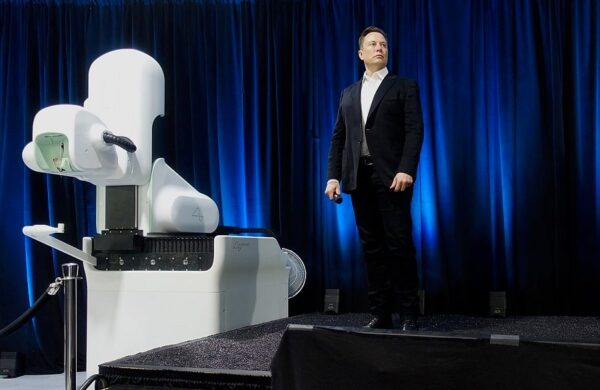
Elon Musk’s Neuralink Takes the First Step Towards Brain-Computer Integration
rajkotupdates.news : elon musk in 2022 neuralink start to implantation of brain chips in humans Elon Musk’s Neuralink has made significant strides in the field of brain-computer integration, marking a groundbreaking achievement in scientific advancement. With the aim of revolutionizing human-machine interaction, Neuralink has successfully completed its first step towards merging technology with the human brain. By developing ultra-thin, flexible threads embedded with electrodes, Neuralink enables direct communication between neurons and external devices.
These threads are inserted into the brain through a minimally invasive surgical procedure. This breakthrough opens up immense possibilities, ranging from treating neurological disorders to enhancing cognitive abilities. With further research and development, Neuralink’s pioneering work has the potential to transform the way we interact with technology and unlock new frontiers in human potential.
The threads are 4 to 6 μm in width, which makes them considerably thinner than a human hair. In addition to developing the threads, Neuralink’s other big advance is a machine that automatically embeds them.
Musk gave a big presentation of Neuralink’s research Tuesday night, though he said that it wasn’t simply for hype. “The main reason for doing this presentation is recruiting,” Musk said, asking people to go apply to work there. Max Hodak, president of Neuralink, also came on stage and admitted that he wasn’t originally sure “this technology was a good idea,” but that Musk convinced him it would be possible.
According to : rajkotupdates.news : elon musk in 2022 neuralink start to implantation of brain chips in humans
In the future, scientists from Neuralink hope to use a laser beam to get through the skull, rather than drilling holes, they said in interviews with The New York Times. Early experiments will be done with neuroscientists at Stanford University, according to that report. “We hope to have this in a human patient by the end of next year,” Musk said.
During a Q&A at the end of the presentation, Musk revealed results that the rest of the team hadn’t realized he would: “A monkey has been able to control a computer with its brain.”It’s not going to be suddenly Neuralink will have this neural lace and start taking over people’s brains,” Musk said. “Ultimately” he wants “to achieve a symbiosis with artificial intelligence.” And that even in a “benign scenario,” humans would be “left behind.” Hence, he wants to create technology that allows a “merging with AI.” He later added “we are a brain in a vat, and that vat is our skull,” and so the goal is to read neural spikes from that brain.
The first person with spinal cord paralysis to receive a brain implant that allowed him to control a computer cursor was Matthew Nagle. In 2006, Nagle played Pong using only his mind; the basic movement required took him only four days to master, he told The New York Times. Since then, paralyzed people with brain implants have also brought objects into focus and moved robotic arms in labs, as part of scientific research. The system Nagle and others have used is called BrainGate and was developed initially at Brown University.
“Neuralink didn’t come out of nowhere, there’s a long history of academic research here,” Hodak said at the presentation on Tuesday. “We’re, in the greatest sense, building on the shoulders of giants.” However, none of the existing technologies fit Neuralink’s goal of directly reading neural spikes in a minimally invasive way.
The system presented today, if it’s functional, may be a substantial advance over older technology. BrainGate relied on the Utah Array, a series of stiff needles that allows for up to 128 electrode channels. Not only is that fewer channels than Neuralink is promising — meaning less data from the brain is being picked up — it’s also stiffer than Neuralink’s threads. That’s a problem for long-term functionality: the brain shifts in the skull but the needles of the array don’t, leading to damage. The thin polymers Neuralink is using may solve that problem.
However, Neuralink’s technology is more difficult to implant than the Utah Array, precisely because it’s so flexible. rajkotupdates.news : elon musk in 2022 neuralink start to implantation of brain chips in humansTo combat that problem, the company has developed ”a neurosurgical robot capable of inserting six threads (192 electrodes) per minute [automatically],” according to the white paper. In photos, it looks something like a cross between a microscope and a sewing machine. It also avoids blood vessels, which may lead to less of an inflammatory response in the brain, the paper says.
For Musk, the central problem of interacting with AI is actually “bandwidth.” You can take in information much more quickly than you push it out via your voice or your thumbs, but you’re already connected to a machine — an idea most closely associated with philosopher Andy Clark. Hence, his goal is for this system to allow humans to more quickly communicate with machines directly from their brains.
Finally, the paper says that Neuralink has developed a custom chip that is better able to read, clean up, and amplify signals from the brain. Right now, it can only transmit data via a wired connection (it uses USB-C), but ultimately the goal is to create a system than can work wirelessly.
That wireless goal will be embodied in a product that Neuralink calls the “N1 sensor,” designed to be embedded inside a human body and transmit its data wirelessly. It may read fewer neurons than the current USB-based prototype. Neuralink intends to implant four of these sensors, three in motor areas and one in a somatosensor area. It will connect wirelessly to an external device mounted behind the ear, which will contain the only battery. “It will be controlled through an iPhone app,” Hodak said.
“There is a whole FDA process we have to go though,” he added, “we haven’t done that yet.” Matthew MacDougall, head surgeon at Neuralink who appeared dressed in scrubs, said on Tuesday that safety is a primary goal, and that ultimately they want it to be “something more like Lasik” eye surgery — including eliminating the need for general anesthesia. The first patients wouldn’t have that non-invasive experience, though.
Right now, though, the company is still working in rats to make sure the platform is stable. But the technology, if it works, is promising: a “high bandwidth” brain connection, implanted via robot surgery. The connection made using thin flexible “threads” would allow many neurons’ activity to be recorded. The hope is for better, more precise outcomes than previous attempts at brain-machine interfaces.

